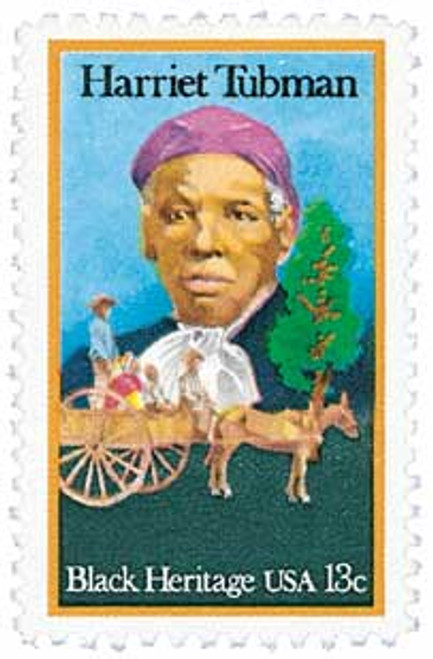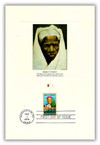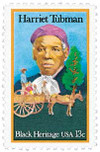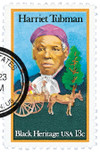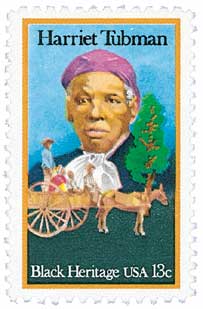
# 1744 - 1978 13c Black Heritage: Harriet Tubman
Black Heritage
Quantity: 156,525,000
Death Of Harriet Tubman
The granddaughter of Africans brought to America in the chain holds of a slave ship, Harriet Tubman was born Araminta “Minty” Ross into slavery on a plantation near Cambridge, Maryland. As no definitive records were kept, she was believed to have been born between 1815 and 1825.
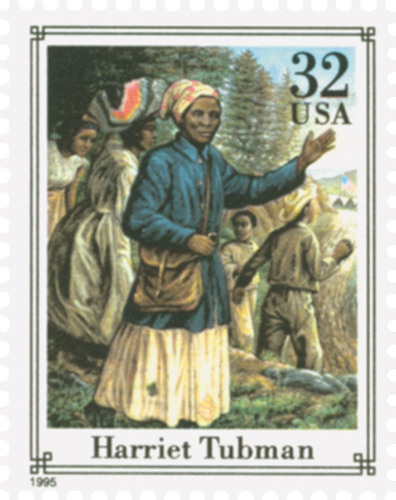
As a child, Tubman watched over her younger brother. When she was five or six, the family she worked for hired Tubman out as nursemaid and later to a nearby farm. In her teen years, Tubman became deeply religious and experienced frequent visions she believed came from God, though some believe they may have been caused by a severe head injury.
In 1844, Tubman married a free black man named John Tubman. Around this time, she changed her name to Harriet to honor her mother. Five years later, when her owner sought to sell her, Tubman decided she wouldn’t allow them to decide her fate and planned her escape. On September 17, 1849, she and two of her brothers made their first attempt. However, he brothers had second thoughts and returned, with Tubman joining them. She then planned another escape on her own. This time she succeeded, taking the Underground Railroad to Philadelphia.
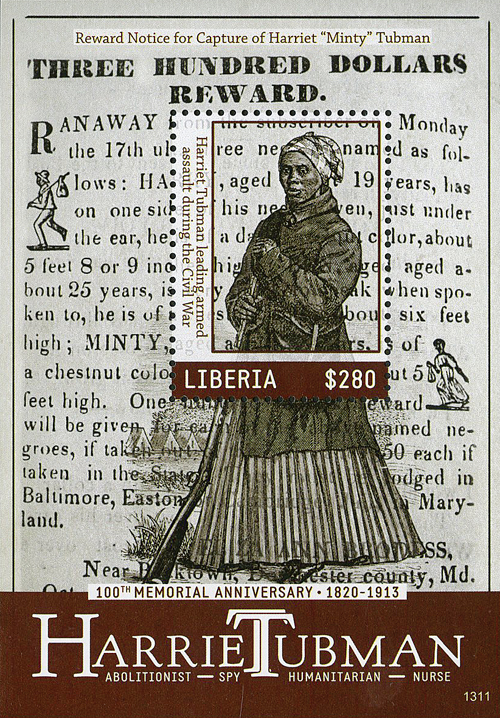
Vowing to help other slaves escape, Tubman made nearly 20 trips back to Maryland. Called “Moses” by her people, after the biblical figure who led the Jews out of Egypt, she became the most famous “conductor” of the Underground Railroad. Although no exact number is known, it is estimated that during the 1850s she helped more than 300 slaves escape to freedom. Rewards for her capture once totaled about $40,000. Remarkably, she was never caught, and never once during any of her rescue trips did anyone get left behind.
At the start of the Civil War, Tubman’s abolitionist friends urged the Union Army to utilize her skills and knowledge. She worked for a time as a cook, nurse, and teacher for liberated slaves in refugee camps. Then, in February 1863, Union officials granted her free passage wherever she wanted to go, an honor rarely bestowed upon a civilian.
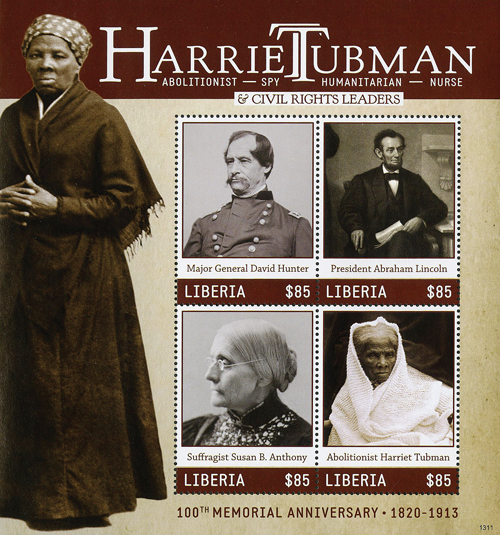
Tubman was then tasked with planning the raid at Combahee Ferry, aimed at freeing hundreds of slaves. Her first task was gathering intelligence and recruiting troops. Union generals gave her money to offer to slaves in South Carolina who could give her vital information such as how many slaves were in certain areas, and the best spots to land for the raid. The raid began on June 2, with the Second South Carolina Volunteer Regiment and Third Rhode Island Heavy Artillery traveling up the Combahee River in the gunboats Harriet A. Weed and John Adams. With Captain Hoyt and Tubman leading the way, the Union troops made three landings after destroying a pontoon bridge.
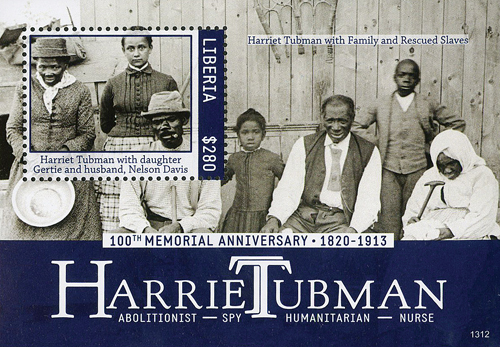
The slaves at Combahee were hesitant at first. As Tubman pointed out, “They wasn’t my people.” They didn’t know any more about her than the white officers she worked with. But with the help of previously freed volunteers, she convinced them to board to the boats – over 750 of them. Of those freed slaves, about 100 joined the Union Army.

After the war, Tubman returned to Auburn, New York, where she helped raise money for black schools. She also joined the women’s suffrage movement, working with Susan B. Anthony. In 1908, she established the Harriet Tubman Home for elderly and needy blacks. Three years later, she was in poor health and had to be admitted there herself. Patrons donated money to provide for her care after a newspaper described her as “ill and penniless.” Tubman died on March 10, 1913, surrounded by friends and family, telling them “I go to prepare a place for you.”
Black Heritage
Quantity: 156,525,000
Death Of Harriet Tubman
The granddaughter of Africans brought to America in the chain holds of a slave ship, Harriet Tubman was born Araminta “Minty” Ross into slavery on a plantation near Cambridge, Maryland. As no definitive records were kept, she was believed to have been born between 1815 and 1825.

As a child, Tubman watched over her younger brother. When she was five or six, the family she worked for hired Tubman out as nursemaid and later to a nearby farm. In her teen years, Tubman became deeply religious and experienced frequent visions she believed came from God, though some believe they may have been caused by a severe head injury.
In 1844, Tubman married a free black man named John Tubman. Around this time, she changed her name to Harriet to honor her mother. Five years later, when her owner sought to sell her, Tubman decided she wouldn’t allow them to decide her fate and planned her escape. On September 17, 1849, she and two of her brothers made their first attempt. However, he brothers had second thoughts and returned, with Tubman joining them. She then planned another escape on her own. This time she succeeded, taking the Underground Railroad to Philadelphia.

Vowing to help other slaves escape, Tubman made nearly 20 trips back to Maryland. Called “Moses” by her people, after the biblical figure who led the Jews out of Egypt, she became the most famous “conductor” of the Underground Railroad. Although no exact number is known, it is estimated that during the 1850s she helped more than 300 slaves escape to freedom. Rewards for her capture once totaled about $40,000. Remarkably, she was never caught, and never once during any of her rescue trips did anyone get left behind.
At the start of the Civil War, Tubman’s abolitionist friends urged the Union Army to utilize her skills and knowledge. She worked for a time as a cook, nurse, and teacher for liberated slaves in refugee camps. Then, in February 1863, Union officials granted her free passage wherever she wanted to go, an honor rarely bestowed upon a civilian.

Tubman was then tasked with planning the raid at Combahee Ferry, aimed at freeing hundreds of slaves. Her first task was gathering intelligence and recruiting troops. Union generals gave her money to offer to slaves in South Carolina who could give her vital information such as how many slaves were in certain areas, and the best spots to land for the raid. The raid began on June 2, with the Second South Carolina Volunteer Regiment and Third Rhode Island Heavy Artillery traveling up the Combahee River in the gunboats Harriet A. Weed and John Adams. With Captain Hoyt and Tubman leading the way, the Union troops made three landings after destroying a pontoon bridge.

The slaves at Combahee were hesitant at first. As Tubman pointed out, “They wasn’t my people.” They didn’t know any more about her than the white officers she worked with. But with the help of previously freed volunteers, she convinced them to board to the boats – over 750 of them. Of those freed slaves, about 100 joined the Union Army.

After the war, Tubman returned to Auburn, New York, where she helped raise money for black schools. She also joined the women’s suffrage movement, working with Susan B. Anthony. In 1908, she established the Harriet Tubman Home for elderly and needy blacks. Three years later, she was in poor health and had to be admitted there herself. Patrons donated money to provide for her care after a newspaper described her as “ill and penniless.” Tubman died on March 10, 1913, surrounded by friends and family, telling them “I go to prepare a place for you.”

